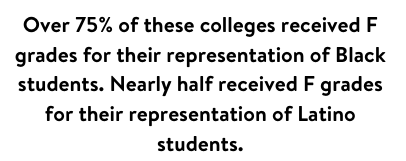 A July report from The Education Trust, a nonprofit research organization, looked at Black and Latino access to 101 of the most selective public universities in America. Each school received a letter grade based on the percentage of Black or Latino students attending these institutions in 2017, compared with the percentage of college-eligible Black or Latino 18- to 24- year-olds in the institution’s state. The results are striking: over 75% of the colleges received F grades for their representation of Black students, and nearly half received F grades for their representation of Latino students.
A July report from The Education Trust, a nonprofit research organization, looked at Black and Latino access to 101 of the most selective public universities in America. Each school received a letter grade based on the percentage of Black or Latino students attending these institutions in 2017, compared with the percentage of college-eligible Black or Latino 18- to 24- year-olds in the institution’s state. The results are striking: over 75% of the colleges received F grades for their representation of Black students, and nearly half received F grades for their representation of Latino students.
EdTrust used several criteria to identify selective public universities, including a designation of state flagship, a Carnegie Foundation-defined high level of research activity, certain average SAT and ACT scores for enrolled students, or state designation as a public honors college. The selective institutions highlighted in the report are all public institutions, tax-exempt and taxpayer-supported, which EdTrust argues should enroll students who represent the racial and ethnic diversity of taxpayers in the states.
Fall enrollment and state demographic information were measured with data from the Integrated Postsecondary Education Data System and the United States Census Bureau.
For example, in Florida, 28.6% of the state’s 18- to 24-year-olds with a high school diploma and no bachelor’s degree are Latino. If the University of Central Florida (UCF)’s student body was 28.6% Latino, they would receive a perfect score of 100. However, only 25.2% of students are Latino, so the institution receives a Latino access score of 88, which translates to a letter grade of B.
The report found that the majority of selective institutions’ access for Black students is regressing. Nearly six in ten selective public colleges had a decrease in the percentage of Black students on their campus in the last twenty years. The story is somewhat better for Latino students; there has been progress, but overall, the numbers are still low. Many institutions saw gains in the percentage of Latino students since 2000, but most states have also seen an increase in the Latino population in their state. In the nine states that house 75% of the nation’s Latino population, most of their selective public institutions earned D and F grades.
While access at most selective institutions has gotten worse, a handful of institutions have made clear commitments to student access and shown improvement. The report highlights UCF in particular for their work to improve Latino student access. In the past two decades, UCF has seen an increase in the percentage of Latino students on campus beyond the increase in the percentage of Latinos in the state. While the percentage of Latino residents in Florida went up nearly ten percentage points, the percentage of Latino students at UCF went up nearly 15 percentage points. Its access grade for Latino students increased from an F in 2000 to a B in 2017.
This increase was no accident. The report argues that increasing access is a matter of will, and there are several steps institutional leaders and policymakers can take to advance access and equity at a state’s colleges and universities. To start, the report suggests institutions across the nation should develop specific goals to increase access for Black and Latino students on their campuses, and should work with other institutions to lead large, scalable practices and share what works. The report additionally recommends that if schools are committed to equitable access, institutions should leverage financial aid dollars to increase aid to Black and Latino students, who are more likely to have unmet financial needs.
Work to improve access can happen outside the colleges as well: across the country, Black and Latino students disproportionately attend high schools that have an inadequate number of school counselors. The report suggests states should ensure Black and Latino students have access to more school counselors, who can help students complete the FAFSA, apply for financial aid, and understand their postsecondary options. Further, institutions can alter recruitment strategies, to develop relationships with and recruit from high schools with high numbers of Black and Latino students. There is great room for potential: many high-achieving lower-income students do not attend selective colleges; however, those who do tend to do just as well as higher-income students.
Florida is the 8th most racially diverse state in the country, and by 2030, Florida’s working-age population will be 54% non-white. Yet today, Black and Latino Floridians trail white Floridians in degree attainment by double digits. If we are to ensure every Floridian has the opportunity to achieve an education beyond high school, many of Florida’s selective colleges have some work to do to achieve enrollment that mirrors the state’s diversity.
RELATED ARTICLES:

